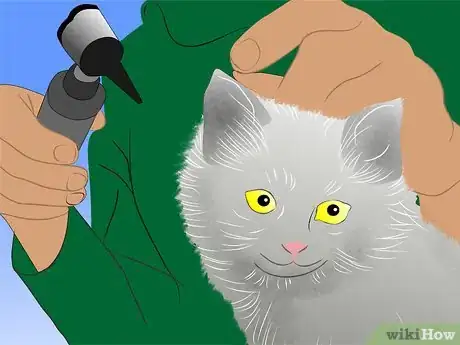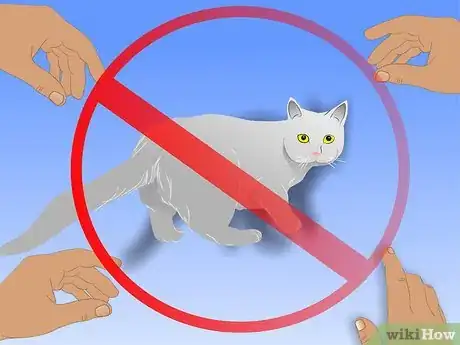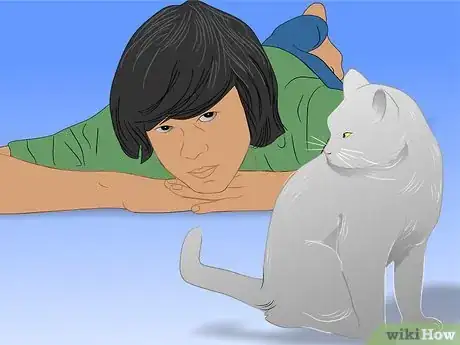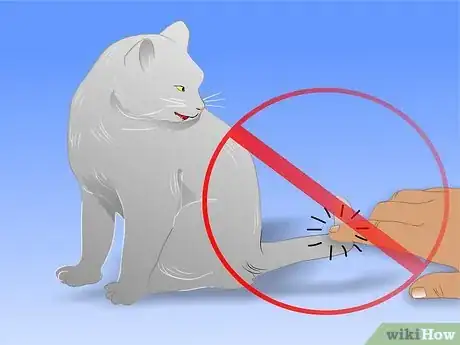wikiHow is a “wiki,” similar to Wikipedia, which means that many of our articles are co-written by multiple authors. To create this article, volunteer authors worked to edit and improve it over time.
There are 7 references cited in this article, which can be found at the bottom of the page.
wikiHow marks an article as reader-approved once it receives enough positive feedback. In this case, 95% of readers who voted found the article helpful, earning it our reader-approved status.
This article has been viewed 42,218 times.
Learn more...
Rehabilitating a physically abused cat is an immensely satisfying undertaking, but it requires vast amounts of patience. If you home a cat that has been abused, it is unlikely the cat will voluntarily socialize with people. From her past experiences, association with human beings means pain, and so she copes as best she either by hiding away to avoid them, or by becoming aggressive when approached.
Steps
Creating a Safe, Calm Environment
-
1Get the cat checked out by a vet as soon as you bring her home. When you first bring an abused cat home, it is a good idea to get her checked by a veterinarian.
- Ask the vet to check if her physical injuries are fully healed and if there are any areas that are still tender or painful for the cat.[1]
- This allows you to judge her medical needs and ensure any courses of treatment are complete. It also helps you to understand if there are any parts of her body that you should avoid touching.
-
2Provide the cat with everything she needs. Bring the cat home and set her up in a quiet room that has everything she needs in it. This includes: food, water, a bed, and a litter tray. Do provide toys but don't feel hurt if she ignores them for several weeks.Advertisement
-
3Give the cat time to adjust to her new environment. At this early stage it is about getting the cat to feel safe in her new environment, even if that space is relatively small to start with.
- It is fine to leave the door open, as long as there aren't boisterous pets around who will intrude in her space and upset her. If this is the case, close the door.
- As her confidence builds then she can freely investigate the rest of the house in her own time.
-
4Make sure the room has plenty of cat-friendly hiding places. Cats feel safe if they are protected on all sides but can see out, which is why cats love cardboard boxes so much. Provide a variety of dens, perhaps boxes in different sizes lying on their sides, and make them comfy with the addition of a blanket or fleece.
-
5Let the cat hide. It may take days, weeks, or months for her to come out of hiding, but remember that you are following her timetable and not yours.
- However, once she realizes that this environment is very different to the abusive household, you should start to see a change in her.
- The first step is for her to realize that there is definitely one place where she is safe (her hide-out), and once she has confidence in that she may start to explore more widely.[2]
-
6Make sure the cat can easily access food and water from her hiding place. Resources such as food and water are high value assets to a cat. It is likely that in the abusive household these were either withheld or it was too dangerous to seek them out.Therefore, the cat's stress is greatly reduced if she has these resources easily available.
- If she hides beneath a bed, put a saucer of biscuits near the edge so that she can snack without having to cross an unfamiliar, scary room to get to them.
-
7Always leave the cat with an escape route. If the does creep out from her hiding place, take care not to stand between her and the safe place. If it appears to her that her escape route is cut off she may panic.
-
8Don't force the cat to socialize with other people. If you figure out that the cat is wary of people, never force her to socialize. Either put her in her safe room when friends come round, or make absolutely sure they know not to look at or approach the cat. This at least will minimize the threat as she perceives it.
Getting to Know One Another
-
1Avoid attempting to make contact with the cat for the first 2 to 3 days. For the first 2 to 3 days under-play contact with the cat. Make sure she has everything she needs and the tray is clean, refresh her water, and top up food, but leave it at that.
- Let her get used to the new sights, sounds, and smells around her. If she wants to come out of her own accord and investigate fine, but if not, leave her be.
- Always speak in a quiet, gentle voice, even if she lashes out and is violent towards you.
-
2Refrain from making eye contact. Never confront the cat by staring at her in her hiding place. Direct eye contact makes a cat feel threatened because in cat language a direct stare is a challenge of authority.[3]
- To them, staring is a signal that the staring-cat wants to be boss, and this is the last thing an abused cat needs in a new home, where you want her to feel confident and safe.
-
3Start to build a relationship by sitting in the same room as the cat. After 2 to 3 days have passed, spend some time in the same room as the cat. Take a good book and a bag of cat treats, settle yourself down to read and have some treats in your hand.
- The idea is to let her get used to your company, and to see that you are not doing anything other than sitting quietly.
- Eventually, if she feels bold enough she may take a tentative step out from her hiding place.
-
4Toss her a treat. Let the watch you for a few minutes and then gently toss a treat in her direction. If she eats it great, but if she scurries back under cover do not fret, it is to be expected.
- This is where bucket loads of patience comes in because you need to be prepared to sit in this way every day for an hour or more if necessary.
- Even then it can take weeks for some cats to build the confidence to start taking the treats.
-
5Draw the cat closer to you with a trail of treats. Once the cat takes a treat at a distance, start leaving the treat a little bit closer each time, setting a trail for her to follow that draws her closer to you.[4]
- Ultimately, the goal is to get her approaching close enough to take a treat from your hand, and eventually allow you to gently pet her.
- In this way get the cat patterned onto treats, which will help her to associate you with pleasant things.
-
6Consider lying on the floor to avoid intimidating the cat. A tip for winning the cat's confidence when she ventures out of hiding is to lie on the floor.[5]
- When standing up, a human is an imposing sight to a cat. Lying on the floor you look less intimidating, making it feel safer for the cat to approach.
- Don't forget to keep those treats handy so you can scatter them on the floor as she draws closer.
- Again, as the cat explores never cut off her escape route in case she need to retrace her steps in a hurry.
-
7Be patient. Remember that behind the fear and shyness there is a lovely cat needing to relearn confidence and trust. It takes time, but if you are patient and kind these animals can repay that kindness a thousandfold. There is so much pleasure to be had, months down the line, in recognizing the immense turnaround possible in these animals.[6]
Dealing with Negative Behaviors
-
1Identify the cat's fears so you can try to avoid them. The rescue agency may give you some idea of the type of abuse the cat suffered. If not, watch how she reacts and what she seems to fear most. Once you have identified what she fears, you can take steps to avoid exposing her to these things.[7]
- When frightened, her eyes will dilate and the pupils become huge and dark. Her fur may stand on head, and she holds her tail straight and the fur is erect so it looks like a bottle brush. Her ears will go back and flatten against her skull.
- If she can run away she will likely scuttle away close to the ground, moving quickly. If she feels trapped she will arch her back, hiss and spit.
-
2Avoid touching the cat in "no-go" areas. "No go" areas are not uncommon in abused cats. For instance, if a cat previously had her pelvis kicked and broken, she won't know being stroked over her hips is a pleasurable thing, but associate it with pain. Thus she is more likely to hiss when you go to touch her there, or try to flee.
- If you are aware of where she least likes to be touched, respect this and do not attempt to stroke her there. Do not persist in forcing physical contact with that area in the mistaken belief that she will get used to it.
- Perhaps in years to come she may let you, but until then you need to win her trust and that means doing exactly what she wants!
-
3Cope with clingy behavior. Some rescued cats become clingy around their new owner. The owner represents safety, and the cat is fearful of being abandoned by you.
- If this is the case put some of your clothing in her cat bed so that she has your scent to comfort her.
- Sometimes it even helps to have another pet to keep her company. This also helps the abused cat because seeing you interacting gently with another animal reassures her.
-
4Deal with any aggression. Some cats have been so badly abused they become aggressive. These cats can be dangerous as they may break regular cat rules of not lashing out unless provoked, and strike out just because you have approached. In her eyes, getting close to her may be provocation enough.[8]
- Part of the difficulty with aggression of this sort is its unpredictability. These cats may not give you the typical warning signals of growling, hissing, swishing the tail, flattening the ears, and dilated pupils. Instead they may strike without warning.
- However, many of these cats can be won over with patience and time. Their aggression is based on fear and attacking is their best form of defense. It takes a combination of knowing there is no pressure for resources, and relearning to trust people in order for them to become less aggressive.
-
5Consider safety first. You cannot force a cat not to be aggressive - again, it is a matter of teaching her that you are not a threat.
- If in doubt, back away from the cat, do not challenge her in order to prove you are not intimidated. That will end with you getting scratched or bitten, and one very angry cat.
- Instead, back off and let her calm down.
-
6Use feline pheromones to lower the cat's stress levels. There are no miracle short cuts, but feline facial pheromones can at least help to lower the cat's stress levels.
- Pheromones are chemicals given off by the cat when she feels relaxed and happy. Cats naturally produce these pheromones to communicate with one another, but there are synthetic versions available (such as Feliway for purchase).
- Spray Feliway on her bedding, or use a Feliway diffuser in the room she spends the most time, as this helps to reassure her. The pheromones label the area as somewhere chilled and relaxed, a bit like playing relaxing music and infusing the air with lavender at a spa.
Community Q&A
-
QuestionThe rescued cat seems to have been abused by people through physical harm. How can I teach my cat know that I intend no harm, and generally how long does it take to feel safe around me?
 Mati_GioCommunity AnswerIt really depends on his age: kittens up to 10 weeks are generally easy to socialise (it will take you a few months), and older cats are mire challenging (can take up to a few years) but not impossible! First of all, have patience. Use treats to reward his good behaviours and remember to never shout at him if he misbehaves as this would scare him. Be gentle and understand his boundaries, pet him only if he is comfortable with it. A good technique is to gently and slowly pat him while he eats, as he will associate food with human-time. Remember to stop if he gets scared and doesn’t want to eat if you pet him. Get him used to your voice and presence and be careful around him.
Mati_GioCommunity AnswerIt really depends on his age: kittens up to 10 weeks are generally easy to socialise (it will take you a few months), and older cats are mire challenging (can take up to a few years) but not impossible! First of all, have patience. Use treats to reward his good behaviours and remember to never shout at him if he misbehaves as this would scare him. Be gentle and understand his boundaries, pet him only if he is comfortable with it. A good technique is to gently and slowly pat him while he eats, as he will associate food with human-time. Remember to stop if he gets scared and doesn’t want to eat if you pet him. Get him used to your voice and presence and be careful around him. -
QuestionI picked up my cat by the belly with one hand aggressively and yelled at her loudly. How can I make amends with her?
 Mati_GioCommunity AnswerNever do it again, there are better methods to discipline your cat. It’s not unfixable but cats have long memories of being harmed, so you'll need to work on it. Be extremely gentle around her, give her treats when she is being more affectionate and pet her gently. If will take a few weeks/months but she’ll be trusting you again if you give her treats more frequently and play with her.
Mati_GioCommunity AnswerNever do it again, there are better methods to discipline your cat. It’s not unfixable but cats have long memories of being harmed, so you'll need to work on it. Be extremely gentle around her, give her treats when she is being more affectionate and pet her gently. If will take a few weeks/months but she’ll be trusting you again if you give her treats more frequently and play with her. -
QuestionWhat do I do if my cat was abused and refuses to eat?
 Community AnswerBecause your cat was abused, it may be the fact that they don't trust humans. Because of this, it'll take time for the cat to adjust and gain trust in you. Also, never starve your cat into eating a certain type of food. Try different things to see if they are being picky about food. If they still don't eat, it is recommended that you take them to a vet as it can result in serious complications such as a liver a complication. Also note whether they use the litter box and drink water. This will help you gain an insight into how healthy they are.
Community AnswerBecause your cat was abused, it may be the fact that they don't trust humans. Because of this, it'll take time for the cat to adjust and gain trust in you. Also, never starve your cat into eating a certain type of food. Try different things to see if they are being picky about food. If they still don't eat, it is recommended that you take them to a vet as it can result in serious complications such as a liver a complication. Also note whether they use the litter box and drink water. This will help you gain an insight into how healthy they are.
Warnings
- Most abused cats taken out of the abusive situation respond by withdrawing to a place they perceive as safe, camp there, and are reluctant to emerge. They are mistrustful of people, and are withdrawn and depressed. If you attempt to confront an abused cat in her lair, you will increase her stress, and she may lash out aggressively.⧼thumbs_response⧽
- Even with months of rehabilitation, the psychological damage caused by the abuse may be too great for the cat to fully integrate into normal family life.⧼thumbs_response⧽
References
- ↑ https://thecatsite.com/c/how-to-help-an-abused-cat-recover/
- ↑ https://www.tasteofthewildpetfood.com/training-behavior/how-to-care-for-a-formerly-abused-pet/
- ↑ https://thecatsite.com/c/how-to-help-an-abused-cat-recover/
- ↑ https://thecatsite.com/c/how-to-help-an-abused-cat-recover/
- ↑ https://thecatsite.com/c/how-to-help-an-abused-cat-recover/
- ↑ https://www.tasteofthewildpetfood.com/training-behavior/how-to-care-for-a-formerly-abused-pet/
- ↑ https://www.battersea.org.uk/pet-advice/cat-advice/cat-anxiety
- ↑ https://www.aspca.org/pet-care/cat-care/common-cat-behavior-issues/aggression-cats
- Feline Behavior: A guide for Veterinarians. Bonnie Beaver. Saunders. 2nd edition


















































































